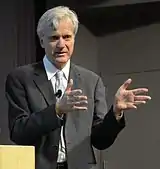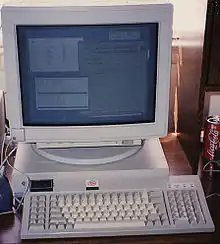Andy Bechtolsheim
Andreas Maria Maximilian Freiherr von Mauchenheim genannt Bechtolsheim (born 30 September 1955[3]) is a German electrical engineer, entrepreneur, investor, and billionaire. He co-founded Sun Microsystems in 1982 and was its chief hardware designer. He later became an investor, providing Sergey Brin and Larry Page with their first round of funding, a $100,000 investment in 1998 before the two had even incorporated their company, Google.[4] His net worth reached $7 billion in September 2018.[2]
Andy Bechtolsheim | |
|---|---|
 Andy Bechtolsheim | |
| Born | 30 September 1955 |
| Nationality | German[1] |
| Known for | Co-founder Sun Microsystems Google investor |
| Net worth | |
Early life
Bechtolsheim was born at Hängeberg am Ammersee, located in Finning, Landsberg, Bavaria,[5] the second of four children. The isolated house had no television or close neighbors, so he experimented with electronics as a child. His family moved to Rome in 1963. Five years later, in 1968, the family relocated again, to Nonnenhorn on Lake Constance in Germany. Aged 16, he designed an industrial controller for a nearby company based on the Intel 8008 which he then programmed in binary code as he had no access to assemblers. Royalties from the product supported much of his education.[6]
As an engineering student at Technical University of Munich Bechtolsheim entered the Jugend forscht contest for young researchers, and after entering for three years, won the physics prize in 1974.[7] At the same time, he had been bored and angry with the level of his studies, which was why he transferred to Carnegie Mellon University in 1975 with the help of a Fulbright scholarship, where he obtained his Master's degree in Computer Science in 1976. In 1977, he transferred to Stanford University and became a Ph.D. student in electrical engineering.[6][8]
Career

At Stanford, Bechtolsheim designed a powerful computer (called a workstation) with built-in networking called the SUN workstation, a name derived from the initials for the Stanford University Network. It was inspired by the Xerox Alto computer developed at the Xerox Palo Alto Research Center. Bechtolsheim was a "no fee consultant" at Xerox, meaning he was not remunerated directly but had free access to the research being done there. At the time, Lynn Conway was using workstations to design very-large-scale integration (VLSI) circuits.[6]
Bechtolsheim's advisor was Forest Baskett. In 1980, Vaughan Pratt also provided leadership to the SUN project. Support was provided by the Computer Science Department and DARPA. The modular computer was used for research projects such as developing the V-System, and for early Internet routers. Bechtolsheim tried to interest other companies in manufacturing the workstations, but only got lukewarm responses.[6]
Founding Sun
One of the companies building computers for VLSI design was Daisy Systems, where Vinod Khosla worked at the time. Khosla had graduated a couple of years earlier from the Stanford Graduate School of Business with Scott McNealy, who managed manufacturing at Onyx Systems. The three wrote a short business plan and quickly received funding from venture capitalists in 1982.[6]

Bechtolsheim left Stanford to found the company, Sun Microsystems, with Bill Joy as employee number one, who was part of the team developing the BSD series of Unix operating systems, was the fourth member of the founding team. For a while Bechtolsheim and Joy shared an apartment in Palo Alto, California.[6]
The first product, the Sun-1, included the Stanford CPU board design with improved memory expansion, and a sheet-metal case. By the end of the year, the experimental Ethernet interface designed by Bechtolsheim was replaced by a commercial board from 3Com.[9]
Sun Microsystems had its initial public offering in 1986 and reached $1 billion in sales by 1988. Bechtolsheim formed a project code-named UniSun around this time to design a small, inexpensive desktop computer for the educational market. The result was the SPARCstation 1 (known as "campus"), the start of another line of Sun products.[10]
Other companies
In 1995, Bechtolsheim left Sun to found Granite Systems, a Gigabit Ethernet startup focused on developing high-speed network switches. In 1996, Cisco Systems acquired the firm for $220 million, with Bechtolsheim owning 60%.[11] He became vice president and general manager of Cisco's Gigabit Systems Business Unit, until leaving the company in December 2003 to head Kealia, Inc.
Bechtolsheim founded Kealia in early 2001 with Stanford Professor David Cheriton, a partner in Granite Systems, to work on advanced server technologies using the Opteron processor from Advanced Micro Devices. In February 2004, Sun Microsystems announced it was acquiring Kealia in a stock swap. Due to the acquisition, Bechtolsheim returned to Sun again as senior vice president and chief architect.[12][13] Kealia hardware technology was used in the Sun Fire X4500 storage product.[14]
Along with Cheriton, in 2005 Bechtolsheim launched another high-speed networking company, Arastra. Arastra later changed its name to Arista Networks. Bechtolsheim left Sun Microsystems to become the Chairman and Chief Development Officer of Arista in October, 2008, but stated he still was associated with Sun in an advisory role.[14]
Investments
Bechtolsheim and Cheriton were two of the first investors in Google, investing US$100,000 each in September 1998. When he gave the check to Larry Page and Sergey Brin, Google's founders, the company had not yet been legally incorporated. Claims that Bechtolsheim coined the name "Google" are untrue. However, he did motivate the founders to officially organize the company under that name.[15][16]
As a result of investments like these, Bechtolsheim was seen as one of the most successful "angel investors",[17] particularly in areas such as electronic design automation (EDA), which refers to the software used by people designing computer chips. He has made a number of successful investments in EDA. In one such EDA company, Magma Design Automation, his stake was valued around $60 million. He was an early investor in another EDA start-up company, Co-Design Automation, which developed SystemVerilog which is used to design almost all digital hardware.
Bechtolsheim invested in Tapulous, the maker of music games for the Apple iPhone.[18] Tapulous was acquired by the Walt Disney Company in 2010.[19] He joined George T. Haber, a former colleague at Sun, to invest in wireless chip company CrestaTech in 2006 and 2008.[20]
Bechtolsheim invested in all of Haber's previous startups: CompCore purchased by Zoran, GigaPixel purchased by 3Dfx and Mobilygen purchased by Maxim Integrated Products in 2008, as well as Moovweb, a cloud-based interface for mobile and computer websites in 2009.[21]
He was reportedly an early investor in Claria Corporation, which ceased operating in 2008.[22] In 2012, Bechtolsheim invested in a Stanford incubated semantic web startup Diffbot.[23] That same year, he was voted by IT Pros in 2012 as the person who contributed most to server innovation in the last 20 years. Two prominent Open Compute innovation leaders will receive awards at Open Server/Open Storage Summit 2013.[24] From 2015 to 2017, Bechtolsheim invested in PerimeterX, an automated attack mitigation SaaS.[25]
Awards
Bechtolsheim received a Smithsonian Leadership Award for Innovation in 1999,[26] a Stanford Entrepreneur Company of the year award, and is a member of the National Academy of Engineering. Bechtolsheim gave the opening keynote speech at the International Supercomputing Conference in 2009.[27]
Personal life
Bechtolsheim has never married, and remains a German national. "I continue to be a German citizen, so I am not an American national. My legal name is the same it always was. The problem with the von is that in America they combine the von title with the last name and my last name is really so long that it actually didn't fit in most computers anymore. So my middle initial is now v. for von and the last name is of course as it always was. That's the peculiarity of the American way of looking at German names."[28]
References
- Karen Southwick High Noon: The Inside Story of Scott McNealy and the Rise of Sun Microsystems By Karen Southwick; retrieved 9 March 2013.
- Andreas von Bechtolsheim profile, forbes.com, 14 February 2018.
- List of richest Germans diereichsten.de; accessed 30 June 2017.(in German)
- Archived 4 April 2017 at the Wayback Machine
- Beise, Marc; Schäfer, Ulrich (11 August 2016). Deutschland digital: Unsere Antwort auf das Silicon Valley. Campus Verlag. ISBN 9783593505923. Retrieved 24 January 2018 – via Google Books.
- Daniel S. Morrow (18 March 1999). "Andreas Bechtolsheim & William Joy Oral History" (PDF). Computerworld International Archives. Archived from the original (PDF) on 22 July 2011. Retrieved 11 April 2011.
- "Die Milliarden-Karriere: Andreas von Bechtolsheim - Bundessieger Physik 1974" (in German). 2006. Archived from the original on 19 July 2011. Retrieved 12 April 2011.
- Leonhard Wolfgang Bibel (2017), Reflexionen vor Reflexen - Memoiren eines Forschers (in German) (1 ed.), Göttingen: Cuvillier Verlag, ISBN 9783736995246
- "Sun Workstation product overview" (PDF). 1982. Retrieved 11 April 2011.
- Karen Southwick (1999). High noon: the inside story of Scott McNealy and the rise of Sun Microsystems. John Wiley and Sons. p. 88. ISBN 978-0-471-29713-0.
- Peter Cohan (November 1997). "Lessons from High-Tech Companies". Journal of Business Strategy.
- Stephen Shankland (11 February 2004). "Sun to buy Opteron server maker, reclaim co-founder". ZDNet. Retrieved 11 April 2011.
- Peter Galli (10 February 2004). "Sun Acquires Server Technology Startup". eWeek. Retrieved 11 April 2011.
- Chris Preimesberger (23 October 2008). "Sun Co-founder Bechtolsheim Joins Cloud Computing Startup". eWeek. Retrieved 11 April 2011.
- Tony Long (7 September 1998). "If the Check Says 'Google Inc.', We're 'Google Inc.'". Wired. Archived from the original on 1 May 2011. Retrieved 11 April 2011.
- "Google history". About Google Company. Archived from the original on 1 April 2011. Retrieved 11 April 2011.
- "Andreas von Bechtolsheim". Forbes. 2006. Archived from the original on 22 May 2011. Retrieved 13 April 2011.
- Jenna Wortham (21 December 2008). "Music Games for iPhone Give Artists New Spotlight". The New York Times. Retrieved 11 April 2011.
- Andy Fixmer and Adam Satariano (1 July 2010). "Disney Buys Tapulous, Maker of Video Games for IPads". Bloomberg Businessweek. Retrieved 11 April 2011.
- "The Programmable Broadband Company:About Us". CrestaTech website. Retrieved 11 April 2011.
- "Bechtolsheim-Backed Moovweb Develops Mobile Sites And Smartphone Apps". 4 November 2009.
- Timothy L. O'Brien and Saul Hansell (20 September 2004). "Barbarians at the Digital Gate". The New York Times. Retrieved 12 April 2011.
- "Archived copy". Archived from the original on 2 September 2013. Retrieved 2013-09-10.CS1 maint: archived copy as title (link)
- Tracie Barnes. "IT Brand Pulse Networking Innovation Leader Awards". Conferenceconcepts.com. Retrieved 3 September 2017.
- Daniel, Robert. "PerimeterX, providing defense against automated attacks, launches anti-bot service". The PE Hub Network. PE Hub. Retrieved 8 August 2017.
- "Past Leadership Award Recipients: 1990–2008". Computerworld Information Technology Awards Foundation. 2008. Archived from the original on 22 July 2011. Retrieved 13 April 2011.
- "An Interview with ISC'09 Keynote Speaker Andy von Bechtolsheim". HPCwire. 21 June 2009. Archived from the original on 2009-07-27. Retrieved 13 April 2011.
- "Von Bechtolsheim: I invested in Google to solve my own problem". Dw.com. Retrieved 3 September 2017.
Further reading
- Carolyn Tajnai (1997). From the Valley of Heart's Delight to the Silicon Valley: A Study of Stanford University's Role in the Transformation (PDF). Stanford University, Department of Computer Science.
- Mark Hall; John Barry (1990). unburst: the ascent of Sun Microsystems. Contemporary Books. ISBN 978-0-8092-4368-6.
External links
- "Odysseys in Technology: Sun Founders Panel". Computer History Museum. 11 January 2006. Archived from the original on 20 April 2011. Retrieved 13 April 2011.
- "SUN display". Stanford University. January 2001. Archived from the original on 20 April 2011. Retrieved 13 April 2011.
- Andreas von Bechtolsheim: Vom Bodensee nach Silicon Valley, Stern.de (in German)